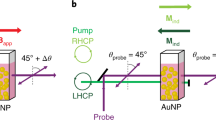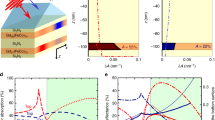Abstract
Plasmonic devices are capable of efficiently confining and enhancing optical fields, serving as a bridge between the realm of diffraction-limited optics and the nanoscale. Specifically, a plasmonic device can be used to locally heat a recording medium for data storage. Ideally, the recording medium would consist of individually addressable and non-interacting entities, a configuration that has been regarded as the ultimate future hard-drive technology. Here, we describe a plasmonic nano-antenna that is fully integrated into a magnetic recording head and its use for thermally assisted magnetic recording on both continuous and fully-ordered patterned media using nanosecond pulses in a static tester configuration. In the case of patterned media at 1.5 Pb m−2 (∼1 Tb inch−2) with 24-nm track pitch, we show ideally written bits without disturbing neighbouring tracks. We find a dramatic improvement in track width and optical efficiency compared to continuous media and show that this is largely due to advantageous near-field optical effects.
This is a preview of subscription content, access via your institution
Access options
Subscribe to this journal
Receive 12 print issues and online access
$209.00 per year
only $17.42 per issue
Buy this article
- Purchase on Springer Link
- Instant access to full article PDF
Prices may be subject to local taxes which are calculated during checkout





Similar content being viewed by others
Change history
11 June 2010
In the version of this article initially published online, the areal density in the caption for Fig. 5b was incorrectly stated as 1.5 Pb inch−2, when it should have been 1.5 Pb m−2. The error has been corrected for all versions of the article.
References
Lyman, P. & Varian, H. R. How much information? http://www.sims.berkeley.edu/how-much-info-2003, (2003).
Wood, R. The feasibility of magnetic recording at 1 terabit per square inch. IEEE Trans. Magn. 36, 36–42 (2000).
Weller, D. & Moser, A. Thermal effect limits in ultrahigh-density magnetic recording. IEEE Trans. Magn. 35, 4423–4439 (1999).
Saga, H., Nemoto, H., Sukeda, H. & Takahashi, M. New recording method combining thermo-magnetic writing and flux detection. Jpn J. Appl. Phys. 38, 1839–1840 (1999).
McDaniel, T. W. Ultimate limits to thermally assisted magnetic recording. J. Phys. Condens. Matter 17, R315–R332 (2005).
Kryder, M. H. et al. Heat assisted magnetic recording. Proc. IEEE 96, 1810–1835 (2008).
Muhlschlegel, P., Eisler, H. J., Martin, O. J. F., Hecht, B. & Pohl, D. W. Resonant optical antennas. Science 308, 1607–1609 (2005).
Schuck, P. J., Fromm, D. P., Sundaramurthy, A., Kino, G. S. & Moerner, W. E. Improving the mismatch between light and nanoscale objects with gold bowtie nanoantennas. Phys. Rev. Lett. 94, 017402 (2005).
Matsumoto, T., Shimano, T., Saga, H., Sukeda, H. & Kiguchi, M. Highly efficient probe with a wedge-shaped metallic plate for high density near-field optical recording. J. Appl. Phys. 95, 3901–3906 (2004).
Challener, W. A., Gage, E., Itagi, A. & Peng, C. Optical transducers for near field recording. Jpn J. Appl. Phys. 45, 6632–6642 (2006).
Srituravanich, W. et al. Flying plasmonic lens in the near field for high-speed nanolithography. Nature Nanotech. 3, 733–737 (2008).
Shi, X. L. & Hesselink, L. Mechanisms for enhancing power throughput from planar nano-apertures for near-field optical data storage. Jpn J. Appl. Phys. 41, 1632–1635 (2002).
Itagi, A. V., Stancil, D. D., Bain, J. A. & Schlesinger, T. E. Ridge waveguide as a near-field optical source. Appl. Phys. Lett. 83, 4474–4476 (2003).
Sendur, K., Peng, C. & Challener, W. Near-field radiation from a ridge waveguide transducer in the vicinity of a solid immersion lens. Phys. Rev. Lett. 94, 043901 (2005).
White, R. L., New, R. M. H. & Pease, R. F. W. Patterned media: a viable route to 50 Gbit in−2 and up for magnetic recording. IEEE Trans. Magn. 33, 990–995 (1997).
Terris, B. D. & Thomson, T. Nanofabricated and self-assembled magnetic structures as data storage media. J. Phys. D 38, R199–R222 (2005).
Challener, W. A. et al. Heat-assisted magnetic recording by a near-field transducer with efficient optical energy transfer. Nature Photon. 3, 220–224 (2009).
Matsumoto, T. et al. Thermally assisted magnetic recording on a bit-patterned medium by using a near-field optical head with a beaked metallic plate. Appl. Phys. Lett. 93, 031108 (2008).
Moser, A., Hellwig, O., Kercher, D. & Dobisz, E. Off-track margin in bit patterned media. Appl. Phys. Lett. 91, 162502 (2007).
Yasui, N. et al. Characterization of high density patterned media fabricated by a new anodizing process. J. Appl. Phys. 103, 07C515 (2008).
Grobis, M. et al. Measurements of the write error rate in bit patterned magnetic recording at 100−320 Gb/in2. Appl. Phys. Lett. 96, 052509 (2010).
Ruiz, R. et al. Density multiplication and improved lithography by directed block copolymer assembly. Science 321, 936–939 (2008).
Hellwig, O. et al. Bit patterned media based on block copolymer directed assembly with narrow magnetic switching field distribution. Appl. Phys. Lett. 96, 052511 (2010).
Martin, Y. C., Hamann, H. F. & Wickramasinghe, K. Strength of the electric field in apertureless near-field optical microscopy. J. Appl. Phys. 89, 5774–5778 (2001).
Johnson, P. B. & Christy, R. W. Optical constants of transition metals: Ti, V, Cr, Mn, Fe, Co, Ni and Pd. Phys. Rev. B 9, 5056–5070 (1974).
Hirotsune, A. et al. Improved grain isolation in [Co/Pd]n multilayer media for thermally assisted magnetic recording. IEEE Trans. Magn. (in the press).
Lim, D.-S., Shin, M.-H., Oh, H.-S. & Kim, Y.-J. Opto-thermal analysis of novel heat assisted magnetic recording media based on surface plasmon enhancement. IEEE Trans. Magn. 45, 3844–3847 (2009).
Sendur, K. & Challener, W. Patterned medium for heat assisted magnetic recording. Appl. Phys. Lett. 94, 032503 (2009).
Acknowledgements
The authors would like to thank many colleagues who supported this work, including T. Matsumoto, H. Miyamoto, T. Olson, T. Hauet, H. Richter, G. Zeltzer, M. Grobis and R. Payne. A part of this work was funded by the New Energy and Industrial Technology Development Organization (NEDO) under the ‘Development of nanobit technology for ultra-high density magnetic recording (Green IT)’ project.
Author information
Authors and Affiliations
Contributions
B.C.S. designed and modelled the integrated plasmonic head, conducted static tester read/write experiments and prepared the manuscript. T.C.S. and C.C.P. designed and developed the light delivery systems, characterized the TAR head, and conducted flying read/write experiments. H.B., T.D.B., J.A.K., J.L. and V.R. fabricated the TAR head. H.N. and A.H. fabricated the continuous media. O.H., R.R., E.D. and D.S.K. fabricated the patterned media. N.R., T.R.A. and B.D.T. guided the team efforts.
Corresponding author
Ethics declarations
Competing interests
The authors declare no competing financial interests.
Supplementary information
Rights and permissions
About this article
Cite this article
Stipe, B., Strand, T., Poon, C. et al. Magnetic recording at 1.5 Pb m−2 using an integrated plasmonic antenna. Nature Photon 4, 484–488 (2010). https://doi.org/10.1038/nphoton.2010.90
Received:
Accepted:
Published:
Issue Date:
DOI: https://doi.org/10.1038/nphoton.2010.90



